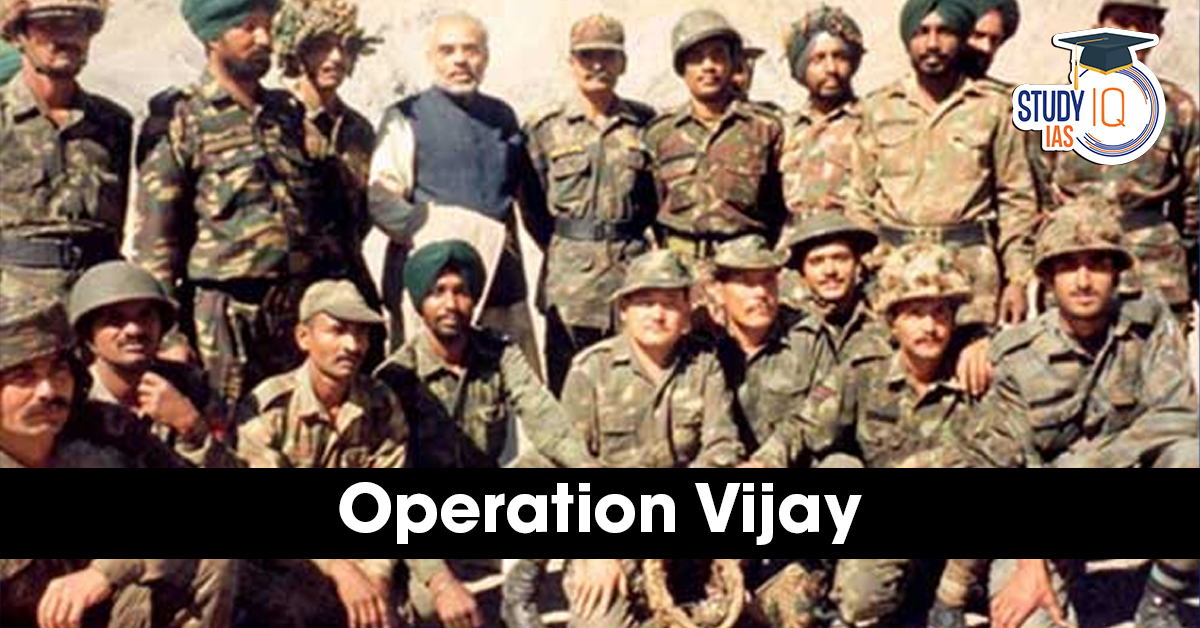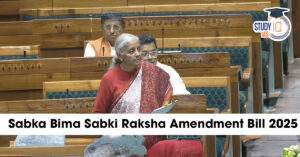Table of Contents
Operation Vijay stands as one of the most significant military campaigns in Indian history. Launched by the Indian Armed Forces in 1999, this operation was a decisive response to the infiltration by Pakistani soldiers and militants into Indian territory during the Kargil War. The operation led to India’s victory in one of the most challenging high-altitude conflicts along the Line of Control (LoC) in Jammu & Kashmir.
What Was Operation Vijay?
Operation Vijay was the codename for the Indian military’s strategic offensive launched in May 1999 to evict Pakistani intruders from the Kargil sector of Ladakh. The operation lasted nearly three months and culminated in the successful restoration of Indian control over the occupied peaks by July 26, 1999. This day is now commemorated annually as Kargil Vijay Diwas.
| Particulars | Details |
|---|---|
| Operation Name | Operation Vijay |
| Duration | May to July 1999 |
| Objective | Evict Pakistani infiltrators from Indian territory in Kargil |
| Outcome | India regained control over key peaks; war ended on 26 July 1999 |
| Significance | Led to victory in the Kargil War and boosted national morale |
Background of the Kargil War
In early 1999, Pakistani soldiers and militants infiltrated Indian positions in the Kargil sector, taking advantage of vacated posts during the harsh winter. Disguised as Kashmiri militants, they occupied strategic heights with the intent to disrupt India’s supply lines to Siachen Glacier and force a change in the LoC.
This clandestine operation by Pakistan was named Operation Badr. Once discovered, India responded swiftly and decisively.
Launch of Operation Vijay
India officially launched Operation Vijay in May 1999 to:
-
Flush out intruders from the Indian side of the LoC.
-
Reclaim control of peaks and strategic ridgelines in Kargil, Dras, Batalik, and Mushkoh sectors.
-
Restore the sanctity of Indian territory and reaffirm military superiority.
More than 200,000 Indian troops were mobilized in a high-altitude environment (above 16,000 feet), making the operation one of the most difficult mountain warfare campaigns in the world.
Major Battles Under Operation Vijay
1. Battle of Tololing
-
First major breakthrough in the Dras sector.
-
Recaptured on 13 June 1999 after heavy casualties.
2. Capture of Point 5140
-
A pivotal victory on 20 June.
-
Captain Vikram Batra famously said, “Yeh Dil Maange More!”
3. Battle of Tiger Hill
-
The most iconic and challenging battle.
-
Won on 7 July 1999 by 18 Grenadiers and 8 Sikhs.
4. Battle of Point 4875
-
Known for the heroic actions of Captain Vikram Batra and Rifleman Sanjay Kumar, both awarded the Param Vir Chakra.
5. Operations in Batalik & Mushkoh
-
Recapture of several strategic peaks in fierce hand-to-hand combat.
Support Operations
Operation Safed Sagar (Indian Air Force)
-
Air strikes began on 26 May 1999.
-
Mirage 2000 jets played a key role in targeting enemy bunkers.
Operation Talwar (Indian Navy)
-
Naval blockade of Karachi port to cut off Pakistani supply lines and apply pressure.
International Reaction
-
United Nations, G8 nations, and United States condemned Pakistan’s intrusion.
-
PM Nawaz Sharif was pressured into agreeing to a troop withdrawal after a meeting with US President Bill Clinton on 4 July 1999.
-
Global opinion stood firmly with India.
Outcome of Operation Vijay
-
By 26 July 1999, Indian troops had regained control of all infiltrated positions.
-
The Kargil War ended in India’s favour and 26 July is celebrated annually as Kargil Vijay Diwas.
Casualties
| Country | Killed | Wounded |
|---|---|---|
| India | 527 | 1,300+ |
| Pakistan | 1,000+ (estimated) | Unknown |
Heroes of Operation Vijay
Several brave soldiers received India’s highest military honours:
-
Captain Vikram Batra – Param Vir Chakra (Posthumous)
-
Lieutenant Manoj Pandey – Param Vir Chakra (Posthumous)
-
Grenadier Yogendra Singh Yadav – Param Vir Chakra
-
Rifleman Sanjay Kumar – Param Vir Chakra
Kargil War Memorial
Located in Dras, Ladakh, the memorial commemorates the sacrifice of Indian soldiers during Operation Vijay. Key features include:
-
The Victory Wall engraved with names of martyrs
-
A museum displaying photographs, letters, and equipment
-
A 100-ft tall national flag symbolizing Indian pride
Aftermath and Reforms
-
Exposed gaps in intelligence and inter-agency coordination
-
Formation of the Kargil Review Committee
-
Strengthening of border surveillance and military modernization
-
Boosted India’s diplomatic image globally, especially with the US and Israel
Impact on Pakistan
-
International diplomatic isolation
-
Loss of credibility on the global stage
-
Political instability followed by a coup by General Pervez Musharraf in October 1999
-
Pakistan later admitted the involvement of regular troops in the war.
Conclusion
Operation Vijay stands as a shining example of India’s military strength, strategic planning, and unwavering national will. It not only safeguarded Indian sovereignty but also immortalized the courage of the armed forces in the icy heights of Kargil. Every year, Kargil Vijay Diwas serves as a solemn reminder of the price of freedom and the valor of those who defend it.


 Future of Governance in Post-Maoist Indi...
Future of Governance in Post-Maoist Indi...
 Sabka Bima Sabki Raksha Amendment Bill 2...
Sabka Bima Sabki Raksha Amendment Bill 2...
 SHANTI Bill 2025: India Opens Nuclear Se...
SHANTI Bill 2025: India Opens Nuclear Se...

























